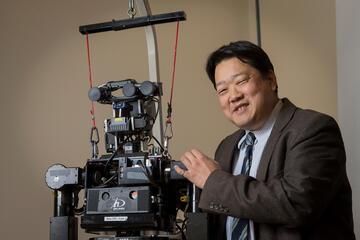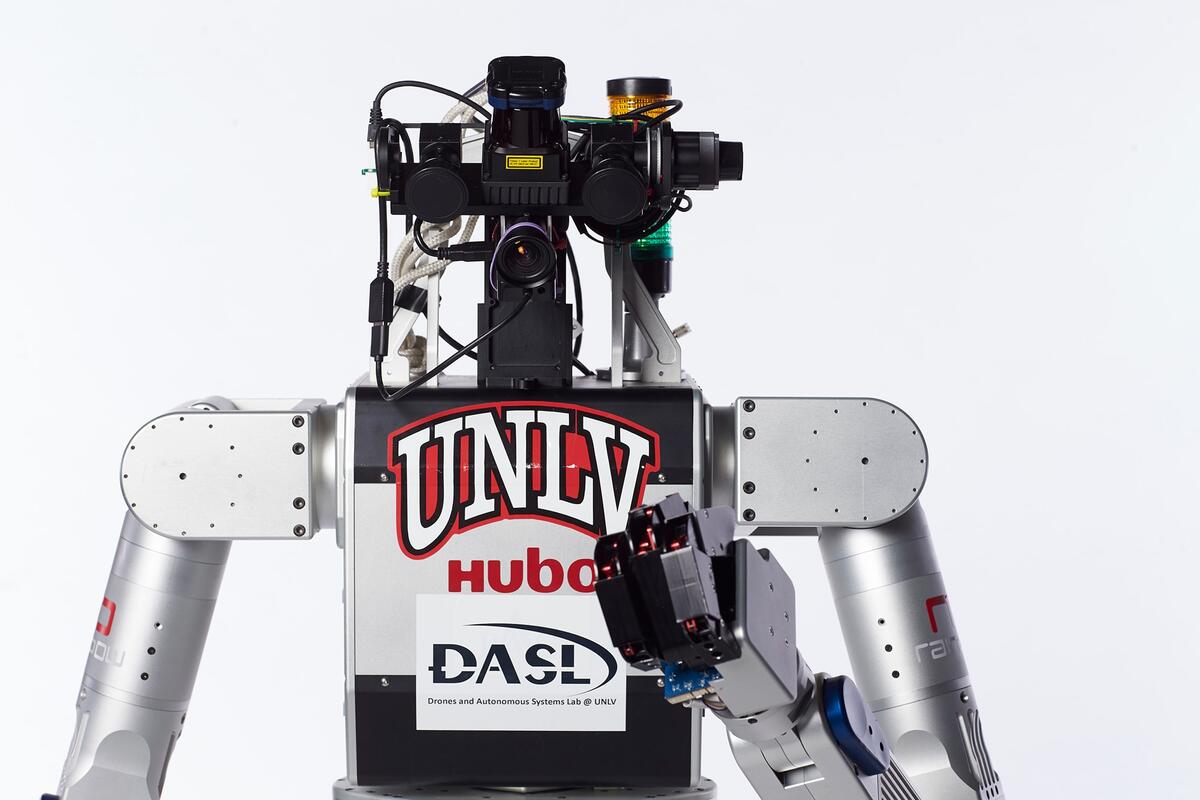He calls it “Roboland,” His Vision Of An Automated systems paradise meant to inspire the inner engineer in us all.
“It will be educational, like the Smithsonian. It will have some rides, like Universal Studios, so families can get their kids excited about science and engineering. And it will be the place to unveil robotics technology, like Las Vegas’ famed Consumer Electronics Show, where people come from all over the world to see tomorrow’s electronics. We can do the same for robotics.”
Welcome to the restless and creative mind of Paul Oh, robot-builder extraordinaire and the recently named Lincy Professor for Unmanned Aerial Systems at UNLV. Oh says he came to Las Vegas because Nevada is poised to become the nation’s premier destination for all manner of “unmanned systems” — robotic machines that have potential to become stronger and faster than their human creators.
But don’t book your Roboland vacation just yet. Though Oh contends that it would be a perfect fit for Las Vegas, he acknowledges that at this point it’s just a dream. In the meantime, however, opportunities to build Nevada’s robotic future abound, he says.
For example, he cites Nevada’s designation as one of six states with Federal Aviation Administration authorization to test unmanned aerial devices for the commercial market. And earlier this year, a UNLV team led by Oh scored a top-10 finish in the Defense Advanced Research Projects Agency (DARPA) Robotics Challenge Finals, the world’s premier showcase for state-of-the-art robots. Among the participants were the international engineering heavyweights Carnegie Mellon, MIT, and NASA.
Oh arrived at UNLV last July by way of Drexel University in Philadelphia, bringing with him more than $1 million in federally Face of the Future funded research grants. Previous to that, he served as a program director for robotics at the National Science Foundation, where he managed a portfolio that supported almost all nonmilitary university robotics research in the U.S. He has also served as a fellow for Boeing, the Office of Naval Research, and the NASA’s Jet Propulsion Lab at CalTech.
Among Oh’s first tasks at UNLV was to establish the Drones and Autonomous Systems Lab (DASL), where he and his team fine-tuned the robot “Metal Rebel” that would participate in the DARPA Robotics Challenge (DRC) Finals.

The DRC was designed to catalyze humanrobot systems development with the goal of helping emergency personnel respond to natural and man-made disasters. According to the DRC website, “teams from some of the most advanced robotics research and development organizations in the world are designing hardware, software, sensors, and human-machine control interfaces to be tested in a series of tasks selected by DARPA for their broad relevance to disaster response operations.”
Oh brought two talented roboticists with him from Drexel, postdoctoral researchers Kiwon Sohn and Youngbum Jun, both of whom took lead roles in the DARPA challenge and have served as co-authors on the numerous research publications that have emerged from it. Graduate student Paresh Brahmbatt, another Drexel transplant who serves as the DASL lab manager, also played a key role. Other team members include graduate and undergraduate students from UNLV, along with a professor and a handful of students from Kookmin University in Seoul, South Korea.
The DARPA challenge, Oh says, was about more than just helping a robot lumber around an obstacle course. The goal was to use the challenge to motivate lab team members to conduct research and to develop projects in an unconventional way, eschewing typical procedures in pursuit of more radical ideas. Oh believes it’s a great way to fuel excitement in the laboratory.
“Over the next two to five years, I want our robotics lab to dazzle,” he says. “Whether it’s with drones, vehicles, or legged-robots, we feel we could really make an impact by partnering with business. It’s part of putting Southern Nevada on the map in the robotics world.”
The team has already published 24 papers emanating from their findings during the DARPA challenge preparations, more than any other participating team.
Many of these published findings focus on how to program and control robots in an environment with “degraded” communications, the type of situation that might ensue following a natural or man-made catastrophe. At the DARPA challenge, robots in such environments are tasked with driving a car, opening a door, turning a valve, removing debris, and climbing stairs. The team’s eighth-place finish was a testament to the research heft of the team, Oh says, but he is interested in pushing the team harder.
“It’s nice to say that we are in the top eight in the world, but sometimes it’s about getting the job done,” Oh says. “The bottom line is that we are developing ideas for companies that are looking for practical, realworld solutions. The important thing now is communicating the results to potential end-users in industry.”
One sign of real-world success was that Metal Rebel emerged as the DARPA challenge’s fastest motorist, completing the driving task in less than one minute. The result was particularly impressive given that many of the 24 teams’ robots didn’t even attempt to drive.
This accomplishment has led Oh to believe that he and his team now have a leg up on the competition when it comes to researching the capabilities of robots behind the wheel. He credits his team’s superior results to their unique approach to the “robots driving” problem. Many At UNLV’s Drones and Autonomous Systems Lab, Paul Oh worked to finetune the robot that would participate in the DARPA Robotics Challenge Finals. research.unlv.edu INNO VATION / 33 of the participants approached the driving task by deploying techniques developed for driverless cars: scanning the environment, building a computer model, then deploying an algorithm to instruct the robot.
Oh’s approach, on the other hand, sought to emulate how a human drives, i.e., by having the robot observe objects as they appear and then reacting to them. Metal Rebel’s triumph indicates that this approach can work, and that, with sufficient refinements, it’s possible similar robots could one day be programmed to drive nearly any non-robotic vehicle. Long-haul trucks, ocean-going ships, rockets into space, you name the conveyance, and Oh can envision a robot at the helm.
Oh also has big plans for a world where unmanned aerial systems will develop limbs, or dexterous manipulators, that can actively interact with objects. The idea is that such creations could assist with all sorts of tasks that are difficult or dangerous for human workers, such as bridge repairs on busy highways or maintenance projects on skyscrapers.
In research funded by the National Science Foundation, Oh and his team are not only building such useful limbs but also working to discover how to utilize them effectively in aircraft. They are conducting research on stabilizing the aircraft while these appendages are at work. Most current research in this area involves systems with wheels or those confined to a clearly defined track. Using limbs on aerial vehicles, Oh says, is “uncharted territory.”
In his typical outside-the-box thinking, he’s looking to the biological world for inspiration. What, he asks, can we learn from the way a monkey uses its tail as a third limb to perch or balance? How does a bird use its beak to build a nest?
“This is cutting-edge work, pioneered by our group and gaining traction all over the world,” Oh says. “It’s a real paradigm shift because most of today’s drones are passive, only taking videos or photos.”
To his colleague, UNLV engineering professor Kwang Kim, this is the type of innovative thinking that sets Oh apart: He possesses the rare combination of both vision and expertise that produces amazing results.
“He has engaged in remarkable research in robotically advanced capabilities,” Kim says. “Paul’s research is forward-looking, and he has been consistently funded by a number of government agencies, including the National Science Foundation and the Department of Defense. He is always thinking of the next innovation in robotics and encouraging his students to think creatively. He is a real asset to UNLV.” Oh is also exploring subjects particularly relevant in Southern Nevada. He wants to explore problems involving water consumption in desert climates, such as creating unmanned aerial vehicles that “rain” on demand, and he’s intrigued by how robotic systems might be better used in cutting water consumption in urban environments.
Another area that has piqued his interest is the service industry, where robots might enhance hospitality at casinos, resorts, or trade shows. Such machines, he says, could allow for more client privacy and a better, high-tech entertainment experience.
And, he muses, they’ll be a ready-made workforce to staff Roboland when the time comes.



